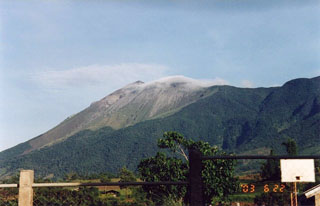Report on Kanlaon (Philippines) — 26 March-1 April 2025
Smithsonian Institution / US Geological Survey
Weekly Volcanic Activity Report, 26 March-1 April 2025
Managing Editor: Sally Sennert.
Please cite this report as:
Global Volcanism Program, 2025. Report on Kanlaon (Philippines) (Sennert, S, ed.). Weekly Volcanic Activity Report, 26 March-1 April 2025. Smithsonian Institution and US Geological Survey.
Kanlaon
Philippines
10.4096°N, 123.13°E; summit elev. 2422 m
All times are local (unless otherwise noted)
The Philippine Institute of Volcanology and Seismology (PHIVOLCS) reported continuing eruptive activity at Kanlaon during 25 March-1 April. The seismic network recorded 6-23 daily volcanic earthquakes, including one period of volcanic tremor lasting one hour and 26 minutes on 29 March and one period of volcanic tremor lasting seven minutes on 31 March. Average daily sulfur dioxide emissions ranged from 1,665 to 3,302 tonnes per day. Moderate-to-voluminous, gas-and-steam emissions that occasionally contained ash generally rose 100-750 m crater rim and drifted W, WSW, and SW; weather conditions obscured views on 28 and 30 March. A period of ash emissions during 1524-1845 on 31 March produced voluminous plumes that rose up to 1.5 km above the crater rim and drifted W. According to a news article minor ashfall was reported in the barangays of Sag-ang in La Castellana (15 km SW) and Ara-al (7 km W) in La Carlota City, along with Binubuhan (17 km WNW), Ilijan (10 km NW), Ma-ao (17 km NW), and Mailum (11 km NW) in Bago City, Quintia. Ash emissions during 0557-0614, 0759-1001, 1028-1041, and 1140-1224 on 1 April rose 300-500 m above the crater rim and drifted SW. The Alert Level remained at 3 (on a scale of 0-5); the public was warned to stay 6 km away from the summit and pilots were warned not to fly close to the volcano.
Geological Summary. Kanlaon volcano (also spelled Canlaon) forms the highest point on the Philippine island of Negros. The massive andesitic stratovolcano is covered with fissure-controlled pyroclastic cones and craters, many of which are filled by lakes. The largest debris avalanche known in the Philippines traveled 33 km SW from Kanlaon. The summit contains a 2-km-wide, elongated northern caldera with a crater lake and a smaller but higher active vent, Lugud crater, to the south. Eruptions recorded since 1866 have typically consisted of phreatic explosions of small-to-moderate size that produce minor local ashfall.
Sources: Philippine Institute of Volcanology and Seismology (PHIVOLCS), Digicast Negros

